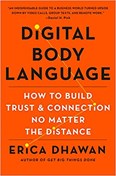- Behaviour
Learn Digital Body Language
A timely guide to communicating with positive emotional connection in the digital space
Body language is extremely powerful, whether consciously or not, we rely on it to connect and build trust. Communicating without being there, physically able to smile, lean in, nod approval, and make eye contact can easily lead to false impressions and misunderstandings.

As the working world contemplates a post-pandemic return to normal, something that blossomed during the crisis and is sure to remain is our ever-greater reliance on virtual communication. In her new book Erica Dhawan demonstrates how what she terms ‘Digital Body Language’ can replicate the traditional cues used in face-to-face interaction with colleagues and customers. And how proficiency in this language can ensure we build trust and connection when working remotely and communicating through email, text, social media, Zoom or other digital means.
From her experience growing up learning to understand two cultures―Indian and American―Dhawan developed a high sensitivity to the emotional nuances of body language. She has used this to inform her exploration of its importance to the way we communicate at work, and how our greater use of virtual communication has led to reports from business leaders of increased experience of disagreement and lack of trust in their organizations.
With non-verbal cues said to comprise 60 to 80 percent of face-to-face communication, a situation where, according to Dhwan, 70 percent of all communication among teams is virtual is bound to be laden with miscues and misunderstanding. Reading emotions is very hard within the digital nature of the modern workplace, which makes emotionally intelligent interaction and leadership difficult. A problem exacerbated when teams are geographically dispersed and recently exaggerated during the Covid-19 crisis.

The aim of Dhwan’s book is to raise the level of communication in and by organizations by helping executives inject empathy and consideration into their everyday emails, texts, video calls, Zoom meetings, etc. She explains how to add cues to our messages that show we are really listening to, respecting, and valuing those we are communicating with. And doing this in a way that takes account of the other person―their gender, generation, culture, or extrovert/introvert personality type. At the core of the book, she offers ‘four laws’ of digital body language: Value Visibly; Communicate Carefully; Collaborate Confidently; and Trust Totally.
Value Visibly is about how to replace the appreciative nod, the smile, the warm thank you handshake, and other signs with visible cues in emails, texts, and video calls―when too often misunderstanding arises from the misreading of ambiguous, curt, or ill-considered messages, even from weird punctuation, or from diverted attention shown on video.
Communicate Carefully and Collaborate Confidently are about the quality and better use of language and teamwork to bring clarity and precision to communication. Trust Totally does not mean unconditionally trusting everyone. Rather it is about creating an open non-judgmental organizational culture where colleagues have faith in each other and in their desire to reach mutual goals―an environment where the general suspicion, sometimes felt when messages appear less than clear or empathetic, is eliminated.
Our experiences through the pandemic have reminded us of the hugely valuable role virtual communication plays in organizations today. It has also highlighted our need to learn a digital body language to replace or complement the traditional physical one.
‘Digital Body Language: How to Build Trust and Connection, No Matter the Distance.’ By Erica Dhawan. Published by Harper Collins, May 2021, ISBN 978-0-008-47652-6
ARTICLES YOU MIGHT LIKE
RESEARCH
LBS and ESMT study identifies the danger of citing information based on the ‘gist’ of the truth rather than the ‘literal’ truth
DEVELOPING LEADERS QUARTERLY MAGAZINE AND WEEKLY BRIEFING EMAILS

































